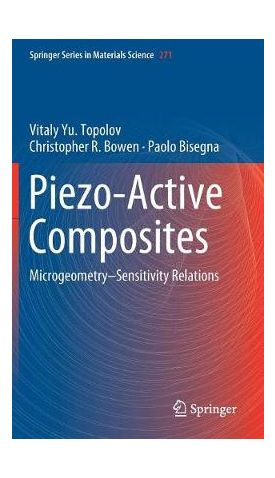אנו משתמשים ב-Cookies כדי לשפר את החוויה שלך. כדי לקיים ההנחיה החדשה של e-Privacy, עלינו לבקש את הסכמתך להגדיר את ה-Cookies. קבלת מידע נוסף.
650.00 ₪
Piezo-Active Composites: Microgeometry-Sensitivity Relations
650.00 ₪
ISBN13
9783319939278
יצא לאור ב
Cham
מהדורה
1st ed. 2018
זמן אספקה
21 ימי עסקים
עמודים
179
פורמט
Hardback
תאריך יציאה לאור
14 ביולי 2018
שם סדרה
Springer Series in Materials Science
This book is devoted to the systematic description of the role of microgeometry of modern piezo-active composites in the formation of their piezoelectric sensitivity.
This book is devoted to the systematic description of the role of microgeometry of modern piezo-active composites in the formation of their piezoelectric sensitivity. In five chapters, the authors analyse kinds of piezoelectric sensitivity for piezo-active composites with specific connectivity patterns and links between the microgeometric feature and piezoelectric response. The role of components and microgeometric factors is discussed in the context of the piezoelectric properties and their anisotropy in the composites. Interrelations between different types of the piezoelectric coefficients are highlighted. This book fills a gap in piezoelectric materials science and provides readers with data on the piezoelectric performance of novel composite materials that are suitable for sensor, transducer, hydroacoustic, energy-harvesting, and other applications.
| מהדורה | 1st ed. 2018 |
|---|---|
| עמודים | 179 |
| פורמט | Hardback |
| ISBN10 | 3319939270 |
| יצא לאור ב | Cham |
| תאריך יציאה לאור | 14 ביולי 2018 |
| תוכן עניינים | Preface 1. Piezoelectric Medium and Piezoelectric Sensitivity 1.1. Piezoelectric Effect and Electromechanical Coupling 1.2. Piezoelectric Coefficients and Sensitivity 1.3. Figures of Merit and Sensitivity 1.4. Effective Electromechanical Properties in Heterogeneous Piezoelectric Materials 1.4.1. Polydomain Ferroelectric Single Crystals 1.4.2. Domain-engineered Relaxor-Ferroelectric Single Crystals 1.4.3. Poled Ferroelectric Ceramics 1.4.4. Piezo-active Composites 1.5. Conclusion 1.6. References 2. Effective Piezoelectric Coefficients dij*: From Microgeometry to Anisotropy 2.1. 2-2-type Composites 2.1.1. Ceramic / Polymer 2.1.2. Single Crystal / Polymer 2.2. 1-3-type Composites 2.2.1. Ceramic / Polymer 2.2.2. Single Crystal / Polymer 2.2.3. 1-3-0 Composites Based on Single Crystals 2.2.4. 1-0-3 Composites Based on Single Crystals 2.3. 1-1-type Composites 2.3.1. Ceramic / Polymer 2.3.2. 1-1-0 Ceramic / Porous Polymer Composites 2.4. 0-3-type Composites 2.5. 3-3-type Composites 2.6. Electromechanical Coupling Factors and Their Relations to dij* 2.7. Hydrostatic Piezoelectric Response and Its Relation to dij* 2.8. Conclusion 2.9. References 3. Microgeometry of Composites and Their Piezoelectric Coefficients gij* 3.1. 2-2-type Composites 3.2. 1-3-type Composites 3.3. 1-1-type Composites 3.4. 0-3-type Composites 3.5. 3-3-type Composites 3.6. Piezoelectric Sensitivity, Figures of Merit and Anisotropy 3.7. Hydrostatic Piezoelectric Sensitivity and Figures of Merit 3.8. Conclusion 3.9. References 4. Piezoelectric Coefficients eij* and dij*: Combination of Properties at Specific Microgeometry 4.1. 2-2-type Composites 4.2. 1-3-type Composites 4.3. 0-3-type Composites 4.4. Conclusion 4.5. References 5. Piezoelectric Coefficients eij* and hij*: Other Combination of Properties 5.1. 2-2-type Composites 5.2. 1-3-type Composites 5.3. 0-3-type Composites 5.5. Conclusion 5.6. References 6. Ways to Improve Piezoelectric Sensitivity of Modern Piezo-active Composites References Acknowledgements Appendix A. List of Abbreviations Appendix B. About the Authors Index |
| זמן אספקה | 21 ימי עסקים |



Login and Registration Form